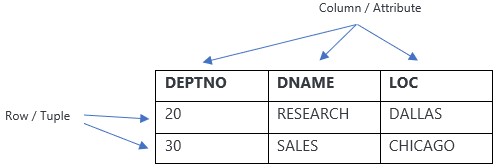DBMS concepts and SQL
Database
A database is an organized collection of structured data, stored electronically in a computer system.
Relational Database
A relational database is a collection of data items organized as logically related tables.

Database Management System
The software required to manage a database is known as a database management system (DBMS).
A DBMS serves as an interface between the database and its end users, allowing users to retrieve, update, and manage how the information is organized and optimized.
A DBMS also facilitates oversight and control of databases, enabling a variety of administrative operations such as performance monitoring, tuning, and backup and recovery.
handle/manipulate these table/relations is known as Relational Database Management System (RDBMS). Some examples of popular DBMSs are MySQL, Microsoft Access, Microsoft SQL Server, FileMaker Pro, Oracle Database, and dBASE.
Table/Relation
A group of rows and columns form a table. The horizontal subset of the Table is known as a Row/Tuple. The vertical subset of the Table is known as a Column/an Attribute.

A relation in a database has the following characteristics:
- Values are atomic.
- Column values are of the same kind.
- Each row is unique.
- The sequence of columns is insignificant.
- The sequence of rows is insignificant.
- Each column must have a unique name.
Database Terminology
Degree
No. of columns of Table.
Cardinality
No. of Rows of Table
Domain
A domain is the collection of values that a data element may contain.
Key
An Attribute/group of attributes in a table that identifies a tuple uniquely is known as a key.
A table may have more than one such attribute/group of identifies that identifies a tuple uniquely, all such attributes(s) are known as Candidate Keys .
Out of Candidate keys, one is selected as Primary key , and others become Alternate Keys .
A Foreign Key is defined in a second table, but it refers to the primary key in the first table.
